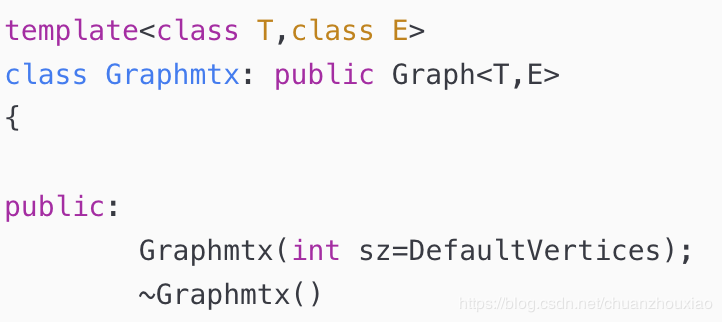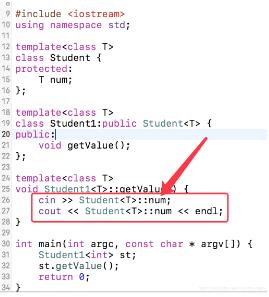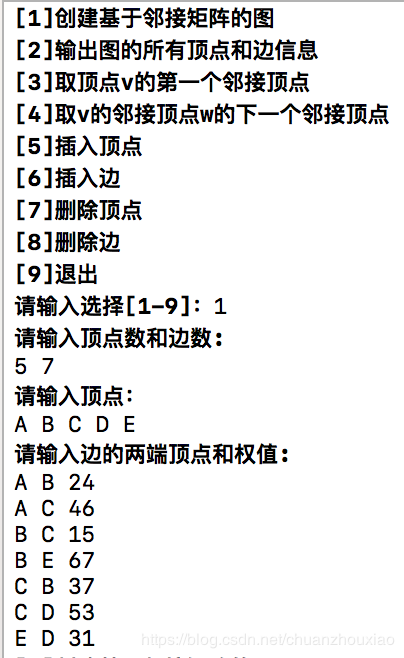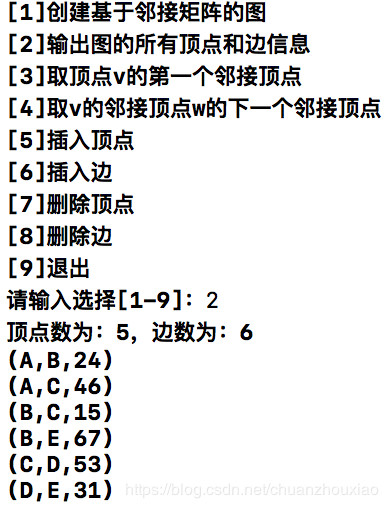本文实例为大家分享了C++实现图的邻接矩阵表示代码,供大家参考,具体内容如下
1.遇到的问题:教材中写着子类Graphmtx(我用GrapMatrix)继承基类Graph

但是我在子类GraphMatrix中使用父类Graph的保护成员属性:maxVertices 显示没有声明(如下图)。

原来,c++中声明一个模板类及子类,在子类中如果需要访问父类的protected变量,需要使用父类的类作用域限定符,否则会报“identifier not found”错误。如果不是模板类,可以直接访问。
例如:要如下这样使用父类的保护成员属性,太麻烦了。

所以,我就不用继承基类的方法了。直接把Graph父类的保护成员属性放到GrapMatrix类中。
2.实现程序:
(1)GraphMatrix.h
- #ifndef GraphMatrix_h
- #define GraphMatrix_h
- #include <iostream>
- using namespace std;
- const int DefaultVertices = 30; // 默认最大顶点数
- template <class T, class E>
- class GraphMatrix {
- public:
- const E maxWeight = 100000; // 代表无穷大的值(=∞)
- GraphMatrix(int sz=DefaultVertices); // 构造函数
- ~GraphMatrix(); // 析构函数
- void inputGraph(); // 创建基于邻接矩阵的图
- void outputGraph(); // 输出图的所有顶点和边信息
- T getValue(int i); // 取顶点i的值,i不合理返回0
- E getWeight(int v1, int v2); // 取边(v1, v2)上的权值
- int getFirstNeighbor(int v); // 取顶点v的第一个邻接顶点
- int getNextNeighbor(int v, int w); // 取v的邻接顶点w的下一个邻接顶点
- bool insertVertex(const T& vertex); // 插入顶点vertice
- bool insertEdge(int v1, int v2, E cost); // 插入边(v1, v2)权值为cost
- bool removeVertex(int v); // 删去顶点v和所有与它相关联的边
- bool removeEdge(int v1, int v2); // 在图中删去边(v1, v2)
- int getVertexPos(T vertex); // 给出顶点vertice在图中的位置
- private:
- int maxVertices; // 图中最大的顶点数
- int numEdges; // 当前边数
- int numVertices; // 当前顶点数
- T *VerticesList; // 顶点表
- E **Edge; // 邻接矩阵
- };
- // 构造函数
- template <class T, class E>
- GraphMatrix<T, E>::GraphMatrix(int sz) {
- int i, j;
- maxVertices = sz;
- numVertices = 0;
- numEdges = 0;
- VerticesList = new T[maxVertices]; // 创建顶点表数组
- Edge = new E*[maxVertices]; // 创建邻接矩阵数组
- for(i = 0; i < maxVertices; i++)
- Edge[i] = new E[maxVertices];
- for(i = 0; i < maxVertices; i++) { // 邻接矩阵初始化
- for(j = 0; j < maxVertices; j++)
- {
- if(i == j) // 矩阵对角处,即为同一顶点
- Edge[i][j] = 0;
- else // 不是同一顶点的,即两顶点一开始没有边相连,为无穷大∞
- Edge[i][j] = maxWeight;
- }
- }
- }
- // 析构函数
- template <class T, class E>
- GraphMatrix<T, E>::~GraphMatrix() {
- delete []VerticesList; // 释放动态分配的空间
- delete []Edge;
- }
- // 创建基于邻接矩阵的图
- template <class T, class E>
- void GraphMatrix<T, E>::inputGraph() {
- int i, j, k;
- int n, m; // 要输入的顶点数和边数
- T e1, e2; // 边的两端顶点
- E weight; // 边对应的权值
- cout << "请输入顶点数和边数:" << endl;
- cin >> n >> m;
- cout << "请输入顶点:" << endl;
- for(i = 0; i < n; i++) { // 建立顶点表数据
- cin >> e1;
- insertVertex(e1); // 插入
- }
- cout << "请输入边的两端顶点和权值:" << endl;
- i = 0;
- while(i < m){ // 输入边
- cin >> e1 >> e2 >> weight; // 输入端点信息
- j = getVertexPos(e1); // 查顶点号
- k = getVertexPos(e2);
- if(j == -1 || k == -1)
- cout << "边两端点信息有误,重新输入!" << endl;
- else {
- insertEdge(j, k, weight);
- i++;
- }
- } // for结束
- }
- // 输出图的所有顶点和边信息
- template <class T, class E>
- void GraphMatrix<T, E>::outputGraph() {
- int i, j, n, m;
- T e1, e2;
- E w;
- n = numVertices;
- m = numEdges;
- cout << "顶点数为:" << n << ",边数为:" << m << endl;
- for(i = 0; i < n; i++) {
- for(j = i+1; j < n; j++) {
- w = getWeight(i, j); // 取边上权值
- if(w > 0 && w < maxWeight) { // 有效,即这两顶点存在边
- e1 = getValue(i);
- e2 = getValue(j);
- cout << "(" << e1 << "," << e2 << "," << w << ")" << endl;
- }
- }
- } // for
- }
- // 给出顶点vertice在图中的位置
- template <class T, class E>
- int GraphMatrix<T, E>::getVertexPos(T vertex) {
- for(int i = 0; i < numVertices; i++)
- if(VerticesList[i] == vertex)
- return i;
- return -1;
- }
- // 取顶点i的值,i不合理返回NULL
- template <class T, class E>
- T GraphMatrix<T, E>::getValue(int i) {
- if(i >= 0 && i < numVertices)
- return VerticesList[i];
- return NULL;
- }
- // 取边(v1, v2)上的权值
- template <class T, class E>
- E GraphMatrix<T, E>::getWeight(int v1, int v2) {
- if(v1 != -1 && v2 != -1) // 存在这两个顶点
- return Edge[v1][v2];
- return 0;
- }
- // 取顶点v的第一个邻接顶点
- template <class T, class E>
- int GraphMatrix<T, E>::getFirstNeighbor(int v) {
- if(v != -1) {
- for(int col = 0; col < numVertices; col++)
- if(Edge[v][col] > 0 && Edge[v][col] <maxWeight)
- return col;
- }
- return -1;
- }
- // 取v的邻接顶点w的下一个邻接顶点
- template <class T, class E>
- int GraphMatrix<T, E>::getNextNeighbor(int v, int w) {
- if(v != -1 && w != -1) {
- for(int col = w+1; col < numVertices; col++) {
- if(Edge[v][col] > 0 && Edge[v][col] < maxWeight)
- return col;
- }
- }
- return -1;
- }
- // 插入顶点vertice
- template <class T, class E>
- bool GraphMatrix<T, E>::insertVertex(const T& vertex) {
- if(numVertices == maxVertices) // 顶点表满
- return false;
- VerticesList[numVertices++] = vertex;
- return true;
- }
- // 插入边(v1, v2)权值为cost
- template <class T, class E>
- bool GraphMatrix<T, E>::GraphMatrix<T, E>::insertEdge(int v1, int v2, E cost) {
- if(v1 > -1 && v1 < numVertices && v2 > -1 && v2 < numVertices && Edge[v1][v2] == maxWeight) { // 顶点v1,v2都存在,并且v1,v2没有边
- Edge[v1][v2] = Edge[v2][v1] = cost;
- numEdges++;
- return true;
- }
- return false;
- }
- // 删去顶点v和所有与它相关联的边
- template <class T, class E>
- bool GraphMatrix<T, E>::removeVertex(int v) {
- if(v < 0 && v > numVertices) // v不在图中,不删除
- return false;
- if(numVertices == 1) // 只剩一个顶点,不删除
- return false;
- int i, j;
- VerticesList[v] = VerticesList[numVertices-1]; // 用最后一个顶点替代当前要删的顶点
- // 删除与v相关联边数
- for(i = 0; i < numVertices; i++) {
- if(Edge[i][v] > 0 && Edge[i][v] < maxWeight)
- numEdges--;
- }
- // 用最后一列,填补第v列
- for(i = 0; i < numVertices; i++)
- Edge[i][v] = Edge[i][numVertices-1];
- numVertices--; // 顶点数减1
- // 用最后一行,填补第v行
- for(j = 0; j < numVertices; j++)
- Edge[v][j] = Edge[numVertices][j];
- return true;
- }
- // 在图中删去边(v1, v2)
- template <class T, class E>
- bool GraphMatrix<T, E>::removeEdge(int v1, int v2) {
- if(v1 > -1 && v1 < numVertices && v2 > -1 && v2 < numVertices && Edge[v1][v2] < maxWeight) {
- Edge[v1][v2] = Edge[v2][v1] = maxWeight;
- numEdges--; // 边数减1
- return true;
- }
- return false;
- }
- #endif /* GraphMatrix_h */
(2)main.cpp
- // 测试数据:
- /*
- 5 7
- A B C D E
- A B 24 A C 46 B C 15 B E 67 C B 37 C D 53 E D 31
- */
- #include "GraphMatrix.h"
- int main(int argc, const char * argv[]) {
- GraphMatrix<char, int> st; // 声明对象
- bool finished = false;
- int choice;
- char e1, e2, next;
- int weight;
- while(!finished) {
- cout << "[1]创建基于邻接矩阵的图" << endl;
- cout << "[2]输出图的所有顶点和边信息" << endl;
- cout << "[3]取顶点v的第一个邻接顶点" << endl;
- cout << "[4]取v的邻接顶点w的下一个邻接顶点" << endl;
- cout << "[5]插入顶点" << endl;
- cout << "[6]插入边" << endl;
- cout << "[7]删除顶点" << endl;
- cout << "[8]删除边" << endl;
- cout << "[9]退出" << endl;
- cout << "请输入选择[1-9]:";
- cin >> choice;
- switch(choice) {
- case 1:
- st.inputGraph();
- break;
- case 2:
- st.outputGraph();
- break;
- case 3:
- cout << "请输入顶点:";
- cin >> e1;
- e2 = st.getValue(st.getFirstNeighbor(st.getVertexPos(e1)));
- if(e2)
- cout << "顶点" << e1 << "的第一个邻接顶点为:" << e2 << endl;
- else
- cout << "顶点" << e1 << "没有邻接顶点!" << endl;
- break;
- case 4:
- cout << "请输入顶点v和邻接顶点w:";
- cin >> e1 >> e2;
- next = st.getValue(st.getNextNeighbor(st.getVertexPos(e1), st.getVertexPos(e2)));
- if(next)
- cout << "顶点" << e1 << "的邻接顶点" << e2 << "的下一个邻接顶点为:" << next << endl;
- else
- cout << "顶点" << e1 << "的邻接顶点" << e2 << "没有下一个邻接顶点!" << endl;
- break;
- case 5:
- cout << "请输入要插入的顶点:";
- cin >> e1;
- if(st.insertVertex(e1))
- cout << "插入成功!" << endl;
- else
- cout << "表已满,插入失败!" << endl;
- break;
- case 6:
- cout << "请输入要插入的边的信息:" << endl;
- cin >> e1 >> e2 >> weight;
- st.insertEdge(st.getVertexPos(e1), st.getVertexPos(e2), weight);
- break;
- case 7:
- cout << "请输入要删除的顶点:";
- cin >> e1;
- if(st.removeVertex(st.getVertexPos(e1)))
- cout << "顶点" << e1 << "已删除!" << endl;
- else
- cout << "顶点" << e1 << "不在图中!" << endl;
- break;
- case 8:
- cout << "请输入要删除的边的两个端点:" << endl;
- cin >> e1 >> e2;
- st.removeEdge(st.getVertexPos(e1), st.getVertexPos(e2));
- break;
- case 9:
- finished = true;
- break;
- default:
- cout << "选择输入错误,请重新输入!" << endl;
- }
- }
- return 0;
- }
测试结果:


以上就是本文的全部内容,希望对大家的学习有所帮助,也希望大家多多支持我们。
原文链接:https://blog.csdn.net/chuanzhouxiao/article/details/88686127














